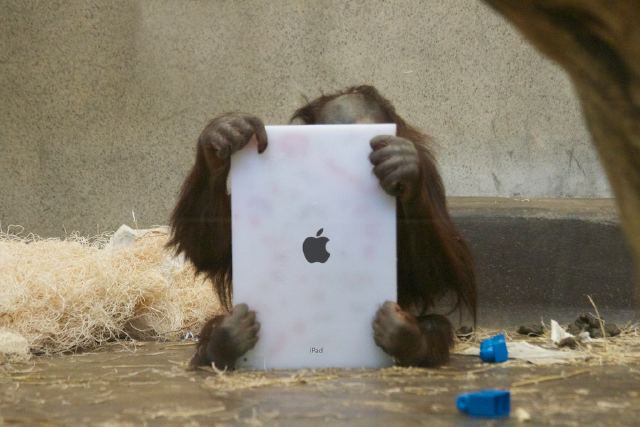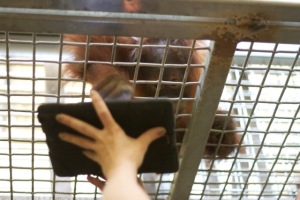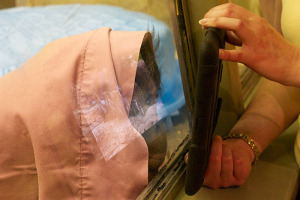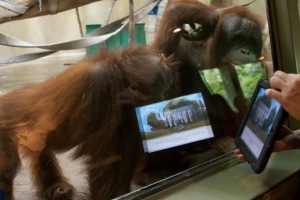An Interview with Orangutan Outreach

The name “orangutan” literally translates into English as “man of the forest”. It comes from Malay and Bahasa Indonesian orang (man) and hutan (forest).
Hitting viral news recently, the Orangutan Outreach charity effort has asked Apple to add a dedicated "Apps for Apes" category to their app store. This followed remarkable results the zoo keepers saw when giving the primate an iPad, allowing enrichment through the likes of Skype, video and picture drawing apps. Regardless of what sort of response (if any) they will receive off the Cupertino based technology company, it shone a spotlight on their conservation efforts.
The Orangutan is a critically endangered species, and the goal of the outreach is to save these highly intelligent creatures. Public support is more important than ever to protect and care for them. We instantly became fascinated by the curiosity that the Orangutans showed to this technology, and had to find out more. We spoke to Richard Zimmerman, Executive Director of Orangutan Outreach.
NRM: What gave you the inspiration to give an Orangutan an iPad, and start the Apples and Orangs program?
 Richard: I immediately thought of it when I watched Steve Jobs give his presentation introducing the iPad. Orangutans have used touchscreens in zoos before and the iPad just seemed like a perfect platform to provide them with lots of exciting enrichment. (This is especially critical for orangutans who are forced to spend large amounts of time indoors during the winter.) The first draft of the project was called Apples for Orangs. The name Apps for Apes had a better ring to it, though... and once the concept and lexicon of ‘apps’ entered the mainstream vernacular, it seemed like a better way to go. The program has evolved with the iPad itself. For instance, once the video functionality was added to the iPads, and the possibility of allowing orangutans to interact online became feasible, allowing the orangutans to use Skype or FaceTime made perfect sense.
Richard: I immediately thought of it when I watched Steve Jobs give his presentation introducing the iPad. Orangutans have used touchscreens in zoos before and the iPad just seemed like a perfect platform to provide them with lots of exciting enrichment. (This is especially critical for orangutans who are forced to spend large amounts of time indoors during the winter.) The first draft of the project was called Apples for Orangs. The name Apps for Apes had a better ring to it, though... and once the concept and lexicon of ‘apps’ entered the mainstream vernacular, it seemed like a better way to go. The program has evolved with the iPad itself. For instance, once the video functionality was added to the iPads, and the possibility of allowing orangutans to interact online became feasible, allowing the orangutans to use Skype or FaceTime made perfect sense.
What observations did you notice about the first time an Orangutan used an iPad?
Orangutans are naturally very curious and tactile, and whenever something new is introduced into their environment they will always have some sort of reaction. Mahal took to it immediately when Scott Engel showed it to him. MJ did as well and loves painting with Milwaukee County Zoo orangutan keeper Trish Khan. Tom, the large male cheekpadder was a bit more skeptical, but he eventually grew curious enough-- and perhaps less afraid-- to engage with the device.
Have you noticed the Orangutans begin to familiarise themselves with the functionality of the apps, and learn how to use the iPad over time?
Yes-- they quickly grow familiar with apps such as painting. We are soo going to start using different types of apps with them to see what they like....
Please note: They are still not allowed to handle the iPads on their own. We are working on a way to make the iPads orangutan-safe, if there is such a thing! We can’t risk them taking apart the iPads and swallowing something hazardous.
Has Apple communicated to you about this, after reaching out to Apple for help publicising your efforts?
Apple has not been in touch..... yet. But we are still hopeful!
Have you had any developers express interest in creating Apps specifically for Apes, and what advice would you give them?
 Yes-- We’ve had a lot of developers contact us and offer free use of their apps. Many have generously offered to work with us for free. We’ve also had offers from engineers and companies that make mounts and robust casings for the iPads.
Yes-- We’ve had a lot of developers contact us and offer free use of their apps. Many have generously offered to work with us for free. We’ve also had offers from engineers and companies that make mounts and robust casings for the iPads.
We are looking into tweaking the main interface in order to make larger icons. Orangutans have very large fingers and an adult male will have trouble using the standard size icons. Their fingertips are twice as big as ours. One thing we have to frequently remind developers of is that orangutans don’t read or use language the way we do-- nor like a small child-- which is a common misconception. So instead of word-based cues, we need to use imagery and icons.
I see from other articles posted about 'Apps for Apes' that the Orangutans respond well to video and video-chat applications such as Skype. Have there been any other types of apps (or specific apps) that have received an active response?
Not yet. But as we scale up the project, this is what we will be looking out for. By working with orangutans in different zoos, we want to put together a ‘best practices’ protocol. This will definitely be a group effort.
You speak of the idea of the Primate Playdate as one thought for looking ahead. What other ideas have you had for the future of the program?
We expect that the orangutans will eventually be able to use their iPads as remote controls-- to open doors and gates in their enclosure in order to choose different spaces. They will also be able to choose their snacks based on a choice of items ( given caloric parameters). We have no idea what will come of the Primate Playdates or how the orangutans will interact. They don’t ‘talk’. They communicate with gestures, facial expressions, noises and movement-- all of which is very ‘present’. We are not sure how this will translate virtually. This information will have to be somehow communicated with meaning.
What will come as a result of these interactions? Orangutan breeding is carefully controlled and guided by a body called the SSP, or Species Survival Program, which makes recommendations based on genetic diversity. Perhaps when an orangutan is scheduled to move to another institution for breeding purposes he or she will be able to select their mate beforehand?
And finally, if all goes well in Apples and Orangs, where would you see the program in ten years? Are we talking Orangutans that are fluent in the use of the iPad?
 10 years is an eternity. Just think about where we humans were technologically in 2002! Or 1992! There was not even a web until the mid-90s. For the orangutans, there are several basic hurdles we need to get around in the beginning-- namely durability and safety. Once we solve this, and cost is no longer a problem, I expect that all zoo orangutans will be using iPads. I think zoo enclosures will evolve with the technology. We are already beginning to see much more advanced design and it is only natural that technology will be incorporated into that design.
10 years is an eternity. Just think about where we humans were technologically in 2002! Or 1992! There was not even a web until the mid-90s. For the orangutans, there are several basic hurdles we need to get around in the beginning-- namely durability and safety. Once we solve this, and cost is no longer a problem, I expect that all zoo orangutans will be using iPads. I think zoo enclosures will evolve with the technology. We are already beginning to see much more advanced design and it is only natural that technology will be incorporated into that design.
We expect that orangutans will be connecting with one another and communicating to the greatest extent that their cognitive development allows. one thing to note is that while this project is geared toward ‘enrichment’, there is already a lot of interest among leading cognitive researchers. That being said, our goal remains to simply do whatever we can to improve the day-to-day lives of orangutans in captivity. On top of that, we hope that zoo visitors (in person) and viewers (online) will develop a fond appreciation and love for orangutans as individuals and as a species which desperately needs to be protected in the wild. That is our over-arching goal-- protecting wild orangutans. And zoo orangutans are in a good position to serve as ambassadors of their wild brethren.
Check out Orangutan Outreach on Facebook, Twitter, and some fascinating videos on Youtube. They are in need of iPads to continue the fantastic work they are doing, so get in touch if you're feeling particularly charitable!
Credit for all photos to Scott Engel.

